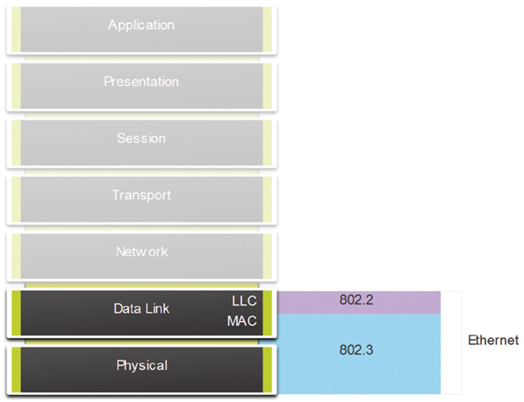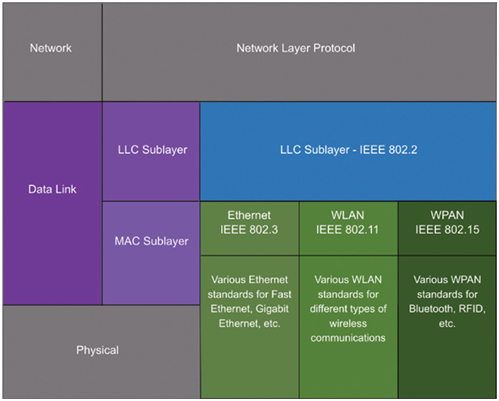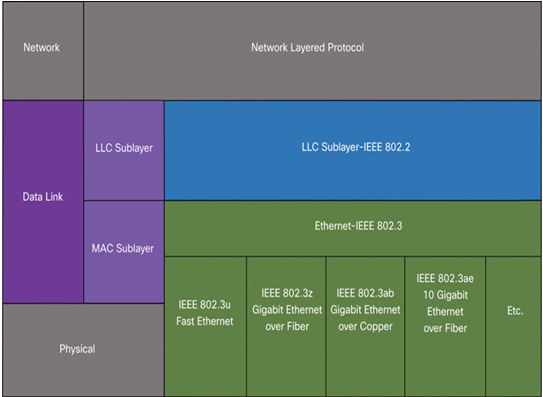Ethernet operates in the data link layer and the physical layer. It is a family of networking technologies that are defined in the IEEE 802.2 and 802.3 standards.
Ethernet Encapsulation (21.2.1)
This module starts with a discussion of Ethernet technology including an explanation of MAC sublayer and the Ethernet frame fields.
Ethernet is one of two LAN technologies used today, with the other being wireless LANs (WLANs). Ethernet uses wired communications, including twisted pair, fiber-optic links, and coaxial cables.
Ethernet operates in the data link layer and the physical layer. It is a family of networking technologies defined in the IEEE 802.2 and 802.3 standards. Ethernet supports data bandwidths of the following:
• 10 Mbps
• 100 Mbps
• 1000 Mbps (1 Gbps)
• 10,000 Mbps (10 Gbps)
• 40,000 Mbps (40 Gbps)
• 100,000 Mbps (100 Gbps)
As shown in Figure 21-2, Ethernet standards define both the Layer 2 protocols and the Layer 1 technologies.

Figure 21-2 Ethernet in the OSI Model
Ethernet is defined by data link layer and physical layer protocols.
IEEE 802 LAN/MAN protocols, including Ethernet, use the following two separate sublayers of the data link layer to operate. They are the Logical Link Control (LLC) and the Media Access Control (MAC), as shown in Figure 21-3.

Figure 21-3 IEEE Ethernet Standards in the OSI Model
Recall that LLC and MAC have the following roles in the data link layer:
• LLC Sublayer — This IEEE 802.2 sublayer communicates between the networking software at the upper layers and the device hardware at the lower layers. It places information in the frame that identifies which network layer protocol is being used for the frame. This information allows multiple Layer 3 protocols, such as IPv4 and IPv6, to use the same network interface and media.
• MAC Sublayer — This sublayer (IEEE 802.3, 802.11, or 802.15 for example) is implemented in hardware and is responsible for data encapsulation and media access control. It provides data link layer addressing and is integrated with various physical layer technologies.
The MAC sublayer is responsible for data encapsulation and accessing the media.
IEEE 802.3 data encapsulation includes the following:
• Ethernet frame — This is the internal structure of the Ethernet frame.
• Ethernet Addressing — The Ethernet frame includes both a source and destination MAC address to deliver the Ethernet frame from Ethernet NIC to Ethernet NIC on the same LAN.
• Ethernet Error detection — The Ethernet frame includes a frame check sequence (FCS) trailer used for error detection.
As shown in Figure 21-4, the IEEE 802.3 MAC sublayer includes the specifications for different Ethernet communications standards over various types of media including copper and fiber.

Figure 21-4 Ethernet Standards in the MAC Sublayer
Recall that legacy Ethernet using a bus topology or hubs, is a shared, half-duplex medium. Ethernet over a half-duplex medium uses a contention-based access method, carrier sense multiple access/collision detection (CSMA/CD) This ensures that only one device is transmitting at a time. CSMA/CD allows multiple devices to share the same half-duplex medium, detecting a collision when more than one device attempts to transmit simultaneously. It also provides a back-off algorithm for retransmission.
Ethernet LANs of today use switches that operate in full-duplex. Full-duplex communications with Ethernet switches do not require access control through CSMA/CD.
